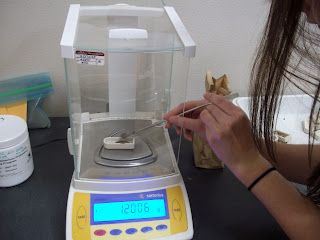 |
| The CAL Lab |
|
After getting the six soil
samples from Sage Garden, the next week we headed over to the Central
Analytical Laboratory where soil testing is done to get a hands-on perspective
of how soils are tested, what they are tested for, and why.
Laboratory soil tests are useful
in helping develop and maintain more productive soil and increase crop
production. The tests provide information on the available nutrient content of
soils. Soil testing helps to select the correct kind and amount of fertilizer
and liming material a soil needs.
The standard soil test that most
laboratories perform includes, but is not limited to: the measurement of
organic matter, phosphorus (P), potassium (K), calcium (Ca), magnesium (Mg),
sodium (Na), and soil pH (acidity). The pH test is the best way to determine
how much lime is needed in a soil. Certain crops might have higher requirements
for specific nutrients.
In our visit to the lab we did
soil testing on the following measurements:
P, K, Ca, Mg, Mn, Cu, B, Zn, Fe,
C%, N%, and pH.





















